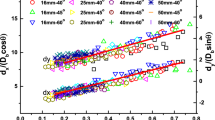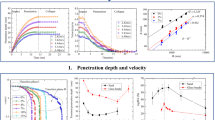Abstract
The results of a series of penetration experiments with cylindrical projectiles (diameter: 30 mm, length: 158 mm) of different tip geometries (hemispherical, conic and flat) impacting with approx. 380 m/s on cylindrical sand targets (diameter: 250 mm, length: 1 m) are presented. The projectiles are instrumented with an on-board data recorder system with acceleration sensor (G-Rec), allowing for in-situ measurement of the decelerations experienced during the impact and during the subsequent penetration process. During and after the acceleration stage inside the gun barrel, the velocities derived from the G-Rec data show a very good agreement with an independent reference velocity measurement obtained by a light barrier system. Immediately after the initial impact on the granular material (compacted sand for this study), the sensor signals indicate very strong amplitude oscillating decelerations in the range of 50,000 to 80,000 g. The measured penetration depth varied widely for identical conditions of projectile impact, using identical preparation procedures for the sand sample. Variables considered for the experimental program included projectile tip shape, initial sand compaction state, and projectile velocity. A data reduction procedure to obtain velocity and position information of the projectile while penetrating the sand assembly is presented, taking into account a constant value (offset) observed in the raw signals of G-Rec at the end of penetration process. The formation of a false tip of agglomerated quartz powder in front of the projectile was observed in all cases. The observed shape of the false tip (penetrator tip with comminuted sand) was found to be identical for all projectile tip shapes (flat, hemispherical, and conical) considered in this study. Initial examination results of the false tip using X-ray computed tomography are presented.















Similar content being viewed by others
References
Allen WA, Mayfield EB, Morrison HL (1957) Dynamics of a projectile penetrating sand. J Appl Phys 28(3):370–376. doi:10.1063/1.1722750
Watanabe K, Tanaka K, Iwane K, Fukuma S, Takayama K, Kobayashi H. Sand behavior induced by high-speed penetration of projectile. In: 7th International Symposium on Impact Engineering (ISIE), Warsaw / Poland, July 4–7 2010. pp 702–708
Collins AL, Addiss JW, Walley SM, Promratana K, Bobaru F, Proud WG, Williamson DM (2011) The effect of rod nose shape on the internal flow fields during the ballistic penetration of sand. Int J Impact Eng 38:13
Bless S, Cooper WL, Watanabe K, Peden R (2012) Deceleration of projectiles in sand. In: Shock Compression of Condensed Matter, 2011. American Institute of Physics, pp 45–47. doi:10.1063/1.3686217
Omidvar M, Malioche JD, Bless S, Iskander M (2015) Phenomenology of rapid projectile penetration into granular soils. Int J Impact Eng 85:146–160
Omidvar M, Bless S, Iskander M (2015) Global observations & post mortem analysis of penetration in sand. In: Iskander M, Bless S, Omidvar M (eds) Rapid penetration into granular media. Elsevier, Amsterdam, pp 145–186
Thompson LJ (1966) Dynamic penetration of selected projectiles into particulate media. Sandia National Laboratories, Albuquerque
Longcope DB Jr (1996) Oblique penetration modeling and correlation with field tests into soil target. Sandia Report SAND96-2239
Lorenz RD, Moersch JE, Stone JA, Morgan AR Jr, Smrekar E (2000) Penetration tests on the DS-2 Mars microprobes: penetration depth and impact accelerometry. Planet Space Sci 48:419–436
Nau S, Külls R, Pilous N, Kisters T. Novel high-g-accelerometer and shock resistant data recorders for penetrators and penetration research. In: 27th International Symposium on Ballistics, Freiburg / Germany, April 22–26 2013
Nau S, Aust V, Pilous N (2011) Generation and measurement of long duration high-g-acceleration profiles. Paper presented at the 55th Annual Fuze Conference, Salt Lake City, May 26
Kuells R, Bruder M, Nau S, Salk M, Thoma K, Hansch W (2014) Design of a 1D and 3D monolithically integrated piezoresistive MEMS high-g accelerometer. In: 2014 International Symposium on Inertial Sensors and Systems (ISISS), pp 1-4. doi: 10.1109/ISISS.2014.6782509
Sill RD (2010) Progress on A 60kG MEMS sensor. In: 54th Annual Fuze Conference, Kansas City, MO, USA, May 11-13 2010, online-proceedings: http://www.dtic.mil/ndia/2010fuze/VASill.pdf
Addiss JW, Collins AL, Proud WG (2009) Investigation of the rate dependence of long-rod penetration of granular media using an improved DSR algorithm. In: Elert ML, Buttler WT, Furnish MD, Anderson WW, Proud WG (eds) 1195 - Shock Compression of Condensed Matter, 2010 2009. American Institute of Physics AIP, pp 1357–1360
Chu AS, Eller EE, Whittier RM (1996) Vibration transducers. In: Harris CM (ed) Shock and vibration handbook. McGraw-Hill, New York, pp 12.11–12.25
Chu AS (1987) Zeroshift of piezoelectric accelerometers in pyroshock measurements (trans: Center TSaVI). The shock and vibration bulletin, vol 1, Reprint - Technical Paper 290, Endevco Corporation edn., Washington, D.C.
Peden R, Bless S, Iskander M. Penetration of granular materials: new experimental techniques. In: 27th International Symposium on Ballistics, Freiburg / Germany, April 22–26, 2013. pp 1443–1452
Cooper WL. Shear stress measurements during high-speed impacts with sand and glass beads. In: Physics AIo (ed) Shock Compression of Condensed Matter, 2012 2011. AIP Conference Proceedings. American Institute of Physics, pp 1455–1458
Cooper WL (2011) Communication of stresses by chains of grains in high-speed particulate media impacts. In: Proulx T (ed) Conference on experimental and applied mechanics, 2011. Dynamic behaviour of materials. Springer, New York, pp 99–108
Penumadu D, Kim FH (2015) Multimodal radiation based tomography and diffractionof granular materials using neutrons and photons and instrumented penetration mechanics. In: Iskander M, Bless S, Omidvar M (eds) Rapid penetration into granular media. Elsevier, Amsterdam, pp 267–290
Acknowledgments
The authors gratefully acknowledge the support of the Defense Threat Reduction Agency (DTRA), Grant No: HDTRA1-12-1-0045
Author information
Authors and Affiliations
Corresponding author
Appendix-1: Data Correction Procedure for G-Rec Sensor and Numerical Integration Scheme
Appendix-1: Data Correction Procedure for G-Rec Sensor and Numerical Integration Scheme
The short-term zero-shift is mathematically described by a decaying exponential function. Together with the constant offset the correction formula can be written as:
The correction was conducted with four of the data sets according to the following procedure:
-
1.
From the raw data, estimate the point in time when the projectile stopped moving.
-
For all data sets tend = 165 ms was chosen.
-
-
2.
Find the starting point of the deceleration phase.
-
For all data sets t0 = 153.5 ms was chosen.
-
-
3.
Chose a value for c, such that the exponential term becomes small at tend.
-
For all data sets c = 400 1/s was chosen, which corresponds to a 1 % remainder at tend.
-
-
4.
Subtract the offset Aconst at tend from the deceleration data.
-
This varied between 200 and 400 g.
-
-
5.
Vary Aexp until the time-integral of the deceleration, i.e. the velocity, matches the impact velocity
-
This varied between 2000 and 4000 g.
-
Rights and permissions
About this article
Cite this article
Glößner, C., Moser, S., Külls, R. et al. Instrumented Projectile Penetration Testing of Granular Materials. Exp Mech 57, 261–272 (2017). https://doi.org/10.1007/s11340-016-0228-0
Received:
Accepted:
Published:
Issue Date:
DOI: https://doi.org/10.1007/s11340-016-0228-0




